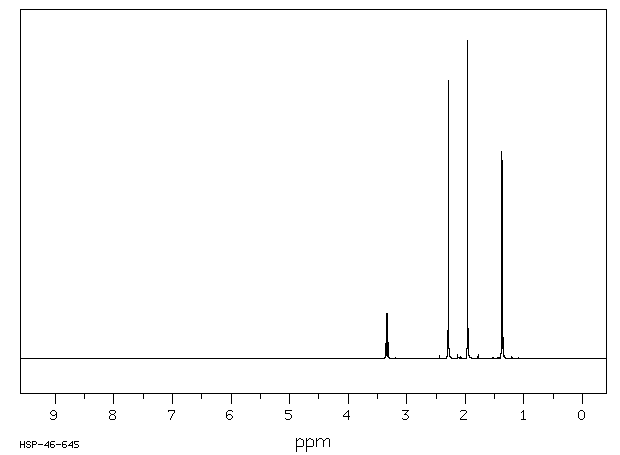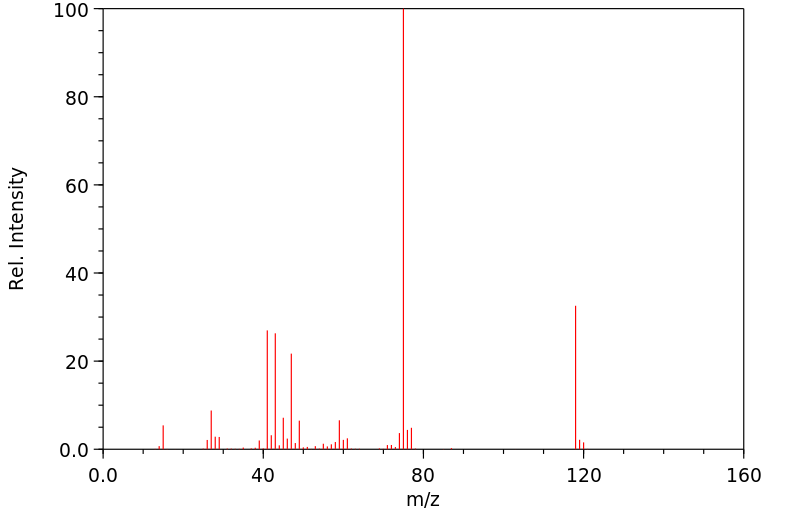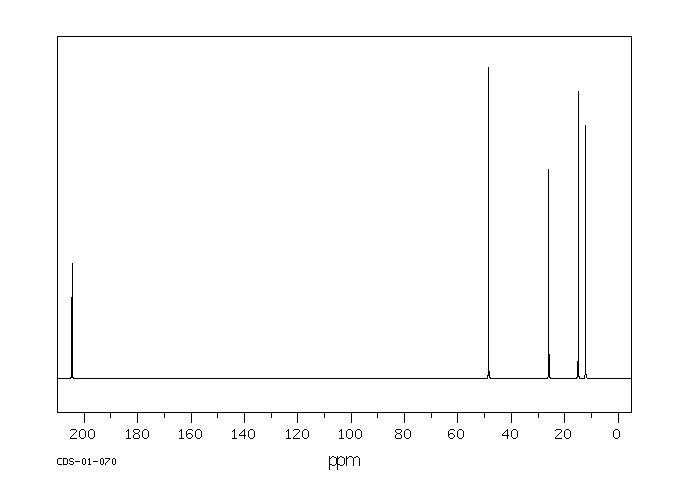3-甲巯基-2-丁酮 | 53475-15-3
中文名称
3-甲巯基-2-丁酮
中文别名
3-甲硫基-2-丁酮;3-甲硫-2-丁酮
英文名称
3-(methylthio)-2-butanone
英文别名
3-methylsulfanylbutan-2-one
CAS
53475-15-3
化学式
C5H10OS
mdl
——
分子量
118.2
InChiKey
HFVLNCDRAMUMCC-UHFFFAOYSA-N
BEILSTEIN
——
EINECS
——
-
物化性质
-
计算性质
-
ADMET
-
安全信息
-
SDS
-
制备方法与用途
-
上下游信息
-
文献信息
-
表征谱图
-
同类化合物
-
相关功能分类
-
相关结构分类
物化性质
-
沸点:50-54 °C20 mm Hg(lit.)
-
密度:0.975 g/mL at 25 °C(lit.)
-
闪点:112 °F
-
LogP:0.84
-
物理描述:Colourless to yellow liquid; Pungent odour
-
溶解度:Sparingly soluble
-
折光率:1.469-1.471
-
稳定性/保质期:
如果按照规格使用和储存,则不会分解,且没有已知危险反应。
计算性质
-
辛醇/水分配系数(LogP):1
-
重原子数:7
-
可旋转键数:2
-
环数:0.0
-
sp3杂化的碳原子比例:0.8
-
拓扑面积:42.4
-
氢给体数:0
-
氢受体数:2
安全信息
-
危险等级:3.2
-
安全说明:S23,S24/25
-
危险类别码:R10
-
WGK Germany:3
-
危险品运输编号:UN 1224 3
-
海关编码:2930909090
-
包装等级:III
-
危险类别:3.2
SDS
模块 1. 化学品
1.1 产品标识符
: 3-甲硫基-2-丁酮
产品名称
1.2 鉴别的其他方法
3-Methylmercapto-2-butanone
1.3 有关的确定了的物质或混合物的用途和建议不适合的用途
仅用于研发。不作为药品、家庭或其它用途。
模块 2. 危险性概述
2.1 GHS-分类
易燃液体 (类别 3)
2.2 GHS 标记要素,包括预防性的陈述
象形图
警示词 警告
危险申明
H226 易燃液体和蒸气
警告申明
预防措施
P210 远离热源、火花、明火和热表面。- 禁止吸烟。
P233 保持容器密闭。
P240 容器和接收设备接地。
P241 使用防爆的电气/ 通风/ 照明 设备。
P242 只能使用不产生火花的工具。
P243 采取措施,防止静电放电。
P280 戴防护手套/穿防护服/戴护目镜/戴面罩.
事故响应
P303 + P361 + P353 如果皮肤(或头发)接触:立即除去/脱掉所有沾污的衣物,用水清洗皮肤/淋
浴。
P370 + P378 火灾时: 用干的砂子,干的化学品或耐醇性的泡沫来灭火。
安全储存
P403 + P235 保持低温,存放于通风良好处。
废弃处置
P501 将内容物/ 容器处理到得到批准的废物处理厂。
2.3 其它危害物 - 无
模块 3. 成分/组成信息
3.1 物 质
: 3-Methylmercapto-2-butanone
别名
: C5H10OS
分子式
: 118.20 g/mol
分子量
无
模块 4. 急救措施
4.1 必要的急救措施描述
一般的建议
请教医生。 向到现场的医生出示此安全技术说明书。
吸入
如果吸入,请将患者移到新鲜空气处。 如呼吸停止,进行人工呼吸。 请教医生。
皮肤接触
用肥皂和大量的水冲洗。 请教医生。
眼睛接触
用水冲洗眼睛作为预防措施。
食入
禁止催吐。 切勿给失去知觉者通过口喂任何东西。 用水漱口。 请教医生。
4.2 主要症状和影响,急性和迟发效应
恶心, 头痛, 呕吐, 据我们所知,此化学,物理和毒性性质尚未经完整的研究。
4.3 及时的医疗处理和所需的特殊处理的说明和指示
无数据资料
模块 5. 消防措施
5.1 灭火介质
灭火方法及灭火剂
小(起始)火时,使用媒介物如“乙醇”泡沫、干化学品或二氧化碳。大火时,尽可能使用水灭火。使用大量(
洪水般的)水以喷雾状应用;水柱可能是无效的。用大量水降温所有受影响的容器。
5.2 源于此物质或混合物的特别的危害
碳氧化物, 硫氧化物
5.3 给消防员的建议
如必要的话,戴自给式呼吸器去救火。
5.4 进一步信息
用水喷雾冷却未打开的容器。
模块 6. 泄露应急处理
6.1 作业人员防护措施、防护装备和应急处置程序
避免吸入蒸气、烟雾或气体。 移去所有火源。 谨防蒸气积累达到可爆炸的浓度。蒸气能在低洼处积聚。
6.2 环境保护措施
如能确保安全,可采取措施防止进一步的泄漏或溢出。 不要让产品进入下水道。
6.3 泄漏化学品的收容、清除方法及所使用的处置材料
围堵溢出,用防电真空清洁器或湿刷子将溢出物收集起来,并放置到容器中去,根据当地规定处理(见第13部
分)。
6.4 参考其他部分
丢弃处理请参阅第13节。
模块 7. 操作处置与储存
7.1 安全操作的注意事项
避免吸入蒸气和烟雾。
切勿靠近火源。-严禁烟火。采取措施防止静电积聚。
7.2 安全储存的条件,包括任何不兼容性
贮存在阴凉处。 使容器保持密闭,储存在干燥通风处。
打开了的容器必须仔细重新封口并保持竖放位置以防止泄漏。
恶臭
7.3 特定用途
无数据资料
模块 8. 接触控制和个体防护
8.1 容许浓度
最高容许浓度
没有已知的国家规定的暴露极限。
8.2 暴露控制
适当的技术控制
根据良好的工业卫生和安全规范进行操作。 休息前和工作结束时洗手。
个体防护设备
眼/面保护
面罩與安全眼鏡请使用经官方标准如NIOSH (美国) 或 EN 166(欧盟) 检测与批准的设备防护眼部。
皮肤保护
戴手套取 手套在使用前必须受检查。
请使用合适的方法脱除手套(不要接触手套外部表面),避免任何皮肤部位接触此产品.
使用后请将被污染过的手套根据相关法律法规和有效的实验室规章程序谨慎处理. 请清洗并吹干双手
所选择的保护手套必须符合EU的89/686/EEC规定和从它衍生出来的EN 376标准。
身体保护
防渗透的衣服, 阻燃防静电防护服,
防护设备的类型必须根据特定工作场所中的危险物的浓度和数量来选择。
呼吸系统防护
如危险性评测显示需要使用空气净化的防毒面具,请使用全面罩式多功能防毒面具(US)或ABEK型
(EN
14387)防毒面具筒作为工程控制的候补。如果防毒面具是保护的唯一方式,则使用全面罩式送风防
毒面具。 呼吸器使用经过测试并通过政府标准如NIOSH(US)或CEN(EU)的呼吸器和零件。
模块 9. 理化特性
9.1 基本的理化特性的信息
a) 外观与性状
形状: 透明, 液体
颜色: 黄色
b) 气味
无数据资料
c) 气味阈值
无数据资料
d) pH值
无数据资料
e) 熔点/凝固点
无数据资料
f) 沸点、初沸点和沸程
50 - 54 °C 在 27 hPa - lit.
g) 闪点
48 °C - 闭杯
h) 蒸发速率
无数据资料
i) 易燃性(固体,气体)
无数据资料
j) 高的/低的燃烧性或爆炸性限度 无数据资料
k) 蒸气压
无数据资料
l) 蒸汽密度
无数据资料
m) 密度/相对密度
0.975 g/cm3 在 25 °C
n) 水溶性
无数据资料
o) n-辛醇/水分配系数
无数据资料
p) 自燃温度
无数据资料
q) 分解温度
无数据资料
r) 粘度
无数据资料
模块 10. 稳定性和反应活性
10.1 反应性
无数据资料
10.2 稳定性
无数据资料
10.3 危险反应
无数据资料
10.4 应避免的条件
热,火焰和火花。
10.5 不相容的物质
强氧化剂强碱, 强氧化剂, 强还原剂
10.6 危险的分解产物
其它分解产物 - 无数据资料
模块 11. 毒理学资料
11.1 毒理学影响的信息
急性毒性
无数据资料
皮肤刺激或腐蚀
无数据资料
眼睛刺激或腐蚀
无数据资料
呼吸道或皮肤过敏
无数据资料
生殖细胞致突变性
无数据资料
致癌性
IARC:
此产品中没有大于或等于 0。1%含量的组分被 IARC鉴别为可能的或肯定的人类致癌物。
生殖毒性
无数据资料
特异性靶器官系统毒性(一次接触)
无数据资料
特异性靶器官系统毒性(反复接触)
无数据资料
吸入危险
无数据资料
潜在的健康影响
吸入 吸入可能有害。 可能引起呼吸道刺激。
摄入 如服入是有害的。
皮肤 通过皮肤吸收可能有害。 可能引起皮肤刺激。
眼睛 可能引起眼睛刺激。
接触后的征兆和症状
恶心, 头痛, 呕吐, 据我们所知,此化学,物理和毒性性质尚未经完整的研究。
附加说明
化学物质毒性作用登记: 无数据资料
模块 12. 生态学资料
12.1 生态毒性
无数据资料
12.2 持久性和降解性
无数据资料
12.3 潜在的生物累积性
无数据资料
12.4 土壤中的迁移性
无数据资料
12.5 PBT 和 vPvB的结果评价
无数据资料
12.6 其它不良影响
无数据资料
模块 13. 废弃处置
13.1 废物处理方法
产品
在装备有加力燃烧室和洗刷设备的化学焚烧炉内燃烧处理,特别在点燃的时候要注意,因为此物质是高度易燃
性物质 将剩余的和不可回收的溶液交给有许可证的公司处理。
联系专业的拥有废弃物处理执照的机构来处理此物质。
受污染的容器和包装
按未用产品处置。
模块 14. 运输信息
14.1 联合国危险货物编号
欧洲陆运危规: 1224 国际海运危规: 1224 国际空运危规: 1224
14.2 联合国运输名称
欧洲陆运危规: KETONES, LIQUID, N.O.S. (DL-3-(Methylthio)butanone)
国际海运危规: KETONES, LIQUID, N.O.S. (DL-3-(Methylthio)butanone)
国际空运危规: Ketones, liquid, n.o.s. (DL-3-(Methylthio)butanone)
14.3 运输危险类别
欧洲陆运危规: 3 国际海运危规: 3 国际空运危规: 3
14.4 包裹组
欧洲陆运危规: III 国际海运危规: III 国际空运危规: III
14.5 环境危险
欧洲陆运危规: 否 国际海运危规 国际空运危规: 否
海洋污染物(是/否): 否
14.6 对使用者的特别提醒
无数据资料
模块 15 - 法规信息
N/A
模块16 - 其他信息
N/A
上下游信息
-
上游原料
中文名称 英文名称 CAS号 化学式 分子量 3-巯基-2-丁酮 3-mercapto-2-butanone 40789-98-8 C4H8OS 104.173
反应信息
-
作为反应物:描述:参考文献:名称:An Acetal Acylation Methodology for Producing Diversity of Trihalomethyl- 1,3‑dielectrophiles and 1,2-Azole Derivatives摘要:A series of functionalized 1,1,1-trihalo-4-methoxy-3-alken-2-ones [CX3C(O)CR1=CROMe, where X = F or Cl; R = n-heptyl, n-octyl, n-nonyl, n-decyl, n-undecyl, n-tridecyl, (CH2)(2)CH=C(Me)(2), (CH2)(2)Ph, (CH2)(2)-(4-HOC6H4), (CH2)(2)-(4-MeOC6H4), (CH2)(2)CO2Me, (CH2)(3)CO2Me, CH(SMe)CH3, CH2(2-MeOC6H4), and R-1 = H, and R = H and R-1 = n-decyl] were synthesized from respective alkyl methyl ketones or aldehyde via acetal acylation using trifluoroacetic anhydride and trichloroacetyl chloride. 1,1,1-Trihalo-4-methoxy-3-alken-2-ones with acid-compatible substituents were easily hydrolyzed to respective trihalomethyl-1,3-diketones. The 1,1,1-trihalo-4-methoxy-3-alken-2-ones and/or respective trihalomethyl-1,3-diketones were reacted regiospecifically with hydroxylamine hydrochloride, leading to isoxazole derivatives, and with hydrazines, leading to respective 1H-pyrazole derivatives. The structures of all compounds were assigned based on nuclear magnetic resonance (NMR) and mass spectrometric data. This method represents an efficient pathway for the regioselective trihaloacetylation of asymmetrically substituted alkyl methyl ketones and highly self-condensing aldehydes. Moreover, this approach allows the introduction of biologically recognizable moieties, such as those from levulinic acid, sulcatone (prenyl), benzylacetone, anisylacetone, and raspberry ketone, as synthetic molecular targets.DOI:10.21577/0103-5053.20190160
-
作为产物:描述:alkaline earth salt of/the/ methylsulfuric acid 在 sodium hydroxide 作用下, 生成 3-甲巯基-2-丁酮参考文献:名称:Boehme; Heller, Chemische Berichte, 1953, vol. 86, p. 443,448摘要:DOI:
文献信息
-
Mono- and polynuclear complexes from the reaction of palladium acetate with α-substituted thioethers and thiols作者:Marino Basato、Diego Tommasi、Marco ZeccaDOI:10.1016/s0022-328x(98)00910-3日期:1998.11trimers decreases with the steric hindrance of the substituents at the sulphur and at the methine carbon atoms. Stable mixed sphere complexes are obtained also with carboxylato ligands different from acetato as PhCOO− and MeSCH2COO−. When the substituted thioether has poor electronwithdrawing groups, its reaction with palladium acetate affords complexes of the type [Pd(η1-OAc)2(RSCH2Z)2], in which the sulphur乙酸钯与α-取代的硫醚(RSCH(R')Z; Z =酯,酮,砜,取代的甲基)和硫醇HSCH 2 C(O)Me反应生成化合物,其组成和核数主要取决于电子性质硫配体。如果它包含足够酸性的氢原子,则乙酰基部分或全部作为乙酸被除去,从而生成[Pd 3(μ- O 2 CMe)3(μ- RSCR'Z)3 ]和[Pd(SCH)2 C(O)Me)2 ] 6。三聚体的稳定性随着取代基在硫和次甲基碳原子上的空间位阻而降低。稳定的混合球复合物与羧酸根也获得配体从如乙酸根不同PhCOO -和MeSCH 2 COO - 。当取代的硫醚具有差的吸电子基团,其与该类型的乙酸钯,得到配合物[钯(反应η 1 -OAc)2(RSCH 2 Z)2 ],其中,所述硫给体原子已经简单地更换的一个氧原子乙酰基配体。
-
Diastereoselective addition to an α-alkoxyaldehyde under dipolar (Cram–Felkin) and chelation (Cram–cyclic) controlled conditions; a stereocontrolled synthesis of (+)-blastmycinone作者:Jun-ichi Uenishi、Hideo Tomozane、Masatoshi YamatoDOI:10.1039/c39850000717日期:——Stereoselective synthesis of anti(2) and syn(3) diols by addition of an acetyl anion equivalent to 2-benzyloxypropanal (1) and stereocontrolled synthesis of (+)-Blastmycinone (11) are described.描述了通过添加等同于2-苄氧基丙醛(1)的乙酰基阴离子的立体选择性合成抗(2)和顺式(3)二醇和立体控制合成(+)-Blastmycinone(11)的方法。
-
Olefin polymerization catalyst and process and polymer, polymer derivatives, lubricants and fuels thereof申请人:——公开号:US20040118035A1公开(公告)日:2004-06-24This invention is directed to a catalyst and an associated process for polymerizing olefins or olefin-containing compounds, to corresponding olefin polymers, to derivatives of the olefin polymers, and to lubricant and fuel compositions that include the olefin polymers or their derivatives. The polymerization catalyst is a metal complex and optional cocatalyst where the metal complex is formed from a bidentate ligand having a nitrogen coordinating group and a second coordinating group selected from oxygen, sulfur, selenium and tellurium groups and a metal compound where the metal is a transition metal, boron, aluminum, germanium or tin. Highly branched and reactive ethylene polymers are formed from the catalyst and process of the present invention. The ethylene polymers and their derivatives are useful in various applications including as performance additives in lubricants and fuels.
-
Promoted Formation of Pyrazines and Sulfur-Containing Volatile Compounds through Interaction of Extra-Added Glutathione or Its Constituent Amino Acids and Secondary Products of Thermally Degraded <i>N</i>-(1-Deoxy-<scp>d</scp>-ribulos-1-yl)-Glutathione作者:Linhui Feng、Heping Cui、Pusen Chen、Khizar Hayat、Xiaoming Zhang、Chi-Tang HoDOI:10.1021/acs.jafc.2c02949日期:2022.7.27extra-added GSH or its constituent amino acids was investigated in the volatile formation during thermal processing of the ARP. Both, the added GSH and its constituent amino acids, could timely capture glyoxal (GO) and methylglyoxal (MGO) to facilitate Strecker degradation, which improved pyrazine formation. Compared with glycine and glutamic acid, cysteine was the most effective extra-added amino acid to制备了源自核糖 (Rib) 和谷胱甘肽 (GSH) 的 Amadori 重排产物 (ARP),并通过超高效液相色谱-串联质谱和核磁共振鉴定为N- (1- deoxy- d -ribulos-1-yl)-glutathione . 对ARP水溶液进行热处理,发现较高的温度会加速ARP的降解。120 ℃时生成的呋喃浓度是100 ℃时的6.39倍以上,特别是高温有利于糠醛和4-羟基-5-甲基-3(2 H)-呋喃酮通过脱氧松酮脱水。研究了额外添加的谷胱甘肽或其组成氨基酸在 ARP 热处理过程中挥发物形成中的促进作用。添加的 GSH 及其组成氨基酸都可以及时捕获乙二醛 (GO) 和甲基乙二醛 (MGO) 以促进 Strecker 降解,从而改善吡嗪的形成。与甘氨酸和谷氨酸相比,半胱氨酸是与GO和MGO反应生成吡嗪和甲基吡嗪最有效的外加氨基酸。更重要的是,额外添加的GSH降解的半胱氨酸通过半胱氨酸降解
-
N-哒嗪吡唑酰胺类化合物
表征谱图
-
氢谱1HNMR
-
质谱MS
-
碳谱13CNMR
-
红外IR
-
拉曼Raman
-
峰位数据
-
峰位匹配
-
表征信息
同类化合物
(反式)-4-壬烯醛
(s)-2,3-二羟基丙酸甲酯
([1-(甲氧基甲基)-1H-1,2,4-三唑-5-基](苯基)甲酮)
(Z)-4-辛烯醛
(S)-氨基甲酸酯β-D-O-葡糖醛酸
(S)-3-(((2,2-二氟-1-羟基-7-(甲基磺酰基)-2,3-二氢-1H-茚满-4-基)氧基)-5-氟苄腈
(R)-氨基甲酸酯β-D-O-葡糖醛酸
(5,5-二甲基-2-(哌啶-2-基)环己烷-1,3-二酮)
(2,5-二氟苯基)-4-哌啶基-甲酮
龙胆苦苷
龙胆二糖甲乙酮氰醇(P)
龙胆二糖丙酮氰醇(P)
龙胆三糖
龙涎酮
齐罗硅酮
齐留通beta-D-葡糖苷酸
鼠李糖
黑芥子苷单钾盐
黑海棉酸钠盐
黑木金合欢素
黑曲霉三糖
黑介子苷
黄尿酸8-O-葡糖苷
麻西那霉素II
麦迪霉素
麦芽糖脎
麦芽糖基海藻糖
麦芽糖1-磷酸酯
麦芽糖
麦芽四糖醇
麦芽四糖
麦芽十糖
麦芽六糖
麦芽五糖水合物
麦芽五糖
麦芽五糖
麦芽五糖
麦芽三糖醇
麦芽三糖
麦芽三糖
麦芽三塘水合
麦芽七糖水合物
麦芽七糖
麦法朵
麦可酚酸-酰基-Β-D-葡糖苷酸
麦利查咪
麝香酮
鹤草酚
鸢尾酚酮 3-C-beta-D-吡喃葡萄糖苷
鸡矢藤苷










